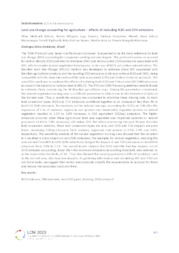Land use change accounting for agriculture - effects of including N2O and CH4 emissions.
Land use change accounting for agriculture - effects of including N2O and CH4 emissions.
Author(s): BATISTA, A. M.; NOVAES, R. M. L.; MACIEN, V. G.; PIGHINELLI, A. L. M. T.; RAMOS, N. P.; MATSUURA, M. I. da S. F.
Summary: The GHG Protocol Land Sector and Removals Guidance is expected to be the main reference for land use change (LUC) accounting for companies seeking net-zero targets. This protocol requires an account for carbon dioxide (CO2) and also for methane (CH4) and nitrous oxide (N2O) emissions associated with LUC, which consider natural vegetation burning and, in the case of N2O, soil carbon mineralization. The Brazilian Land Use Change (BRLUC) method was developed to estimate direct LUC associated with Brazilian agricultural products and the resulting CO2 emissions (until now without N2O and CH4), being compatible with the main international life cycle assessment (LCA) and Carbon Footprint protocols. The aim of this work was to evaluate the effects of including both N2O and CH4 on total LUC GHG emissions to support the decision to include them in BRLUC. The IPCC and GHG Protocol guidelines were followed to estimate them, considering the 64 Brazilian agricultural crops. Among the parameters considered, the natural vegetation burning area is a difficult parameter to obtain due to the limitation of data on the burned area. Thus, a sensitivity analysis was conducted to minimize these missing data. In most land conversion types, N2O and CH4 emissions contribute together to an increase of less than 3% in total LUC GHG emissions. For example, on the national average, accounting for N2O and CH4 after the expansion of 1 ha of soybean, sugarcane and pasture over moderately degraded pasture or natural vegetation resulted in 1.2% to 2.0% increases in CO2 equivalent (CO2eq) emissions. The higher emissions occurred when these agricultural land uses expanded over improved pastures or natural grasslands (3.4% to 7.8% increases), still below 10%. But when considering the past 20-year Brazilian land conversion patterns, these land conversion types are rare, and N2O and CH4 impacts are even lower, increasing CO2eq emissions from soybean, sugarcane and pasture in 0.9%, 0.9% and 0.4%, respectively. The sensitivity analysis of the natural vegetation burning area showed that the variation in it resulted in a low impact on non-GHG emissions. For example, for natural vegetation, reducing the area burned from 88% to 44% (50% reduction) changed the impact of non-CO2 emissions on total GHG emissions from 2.0% to 1.1%. The overall results showed that N2O and CH4 had low impacts in LUC GHG emission accounting, lower than the minimum emissions accounting threshold, also referred to as the materiality threshold, of 5%. They also showed that varying parameters difficult to obtain, such as the burned area, also have low impacts. As gathering information and calculating LUC non-CO2 are not trivial tasks, we suggest that norms and protocols simplify the requirements to account for them and reduce the associated costs and time.
Publication year: 2023
Types of publication: Abstract in annals or event proceedings
Unit: Embrapa Environment
Keywords: Burning, CH4 emission, Emissions, GHG protocol, N2O emission, Non-CO2 gases
Observation
Some of Embrapa's publications are published as ePub files. To read them, use or download one of the following free software options to your computer or mobile device. Android: Google Play Books; IOS: iBooks; Windows and Linux: Calibre.
Access other publications
Access the Agricultural Research Database (BDPA) to consult Embrapa's full library collection and records.
Visit Embrapa Bookstore to purchase books and other publications sold by Embrapa.

